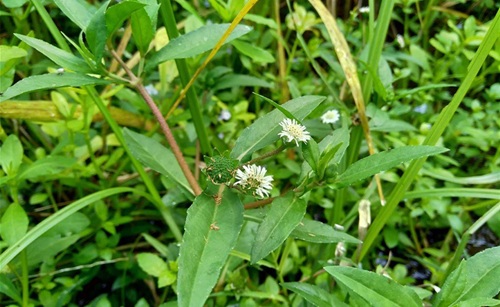Bhringraj is a highly valued medicinal herb in Ayurveda and traditional Indian medicine. Popularly called the “king of hair,” it is most renowned for promoting hair growth and preventing premature greying. Apart from its cosmetic benefits, Bhringraj is also used for liver health, skin ailments, and as a natural detoxifier. Since it often grows wild in moist areas and is sometimes confused with other weeds, it becomes essential to know how to correctly identify the true Bhringraj plant.

1. Botanical Classification
- Scientific Name: Eclipta prostrata / Eclipta alba
- Family: Asteraceae (Sunflower family)
- Common Names: False Daisy (English), Bhringraj (Hindi/Sanskrit), Karisalankanni (Tamil), Kesuriya (Bengali), Bhangra (Punjabi).
Knowing its family and scientific name helps avoid confusion with other similar-looking plants.
2. Plant Size and Growth Pattern
Bhringraj is a small annual herb that usually grows up to 3 to 6 inches tall, though in moist and fertile soil, it can spread more widely. It is a creeping and moisture-loving plant often found near water bodies, riverbanks, and damp fields.
- Growth Habit: Creeping and spreading along the ground.
- Stem: The stem is green, round, and slightly hairy to touch.
3. Leaves
The leaves of Bhringraj are one of its most distinct features.
- Shape: Long, narrow, and lance-shaped (elongated oval).
- Size: About 3–6 cm long.
- Texture: Rough and hairy on both sides.
- Color: Dark green.
- Arrangement: Opposite – meaning the leaves grow in pairs, directly across from each other on the stem.
When you rub the leaf, it gives off a slightly bitter taste and herbal smell.
4. Flowers
Bhringraj is part of the sunflower family, which explains its small daisy-like flowers.
- Type: Small, button-shaped flower heads.
- Color: White (sometimes pale yellow in other varieties).
- Size: About 6–8 mm in diameter.
- Position: Flowers grow singly at the end of branches or leaf axils.
These tiny white flowers are a key identifier—if you see small round heads instead of large petals, it’s most likely Bhringraj.
5. Seeds and Roots
- Seeds: Tiny, black, and elongated. They fall off easily and help in rapid spreading.
- Roots: Fibrous and shallow, making it easy to uproot.
6. Habitat and Season
Bhringraj grows widely across India, Nepal, Thailand, China, and other tropical regions. It prefers moist soil and is often seen during the monsoon season. If you find a creeping green plant with small white flowers near ponds, rice fields, or damp backyards, there’s a high chance it’s Bhringraj.
7. Simple Identification Tests
- Crush Test: When the leaves are crushed, they release a greenish-black juice. This juice is often used directly for hair application.
- Taste Test: The leaves are extremely bitter (not recommended for casual tasting, but used traditionally for liver tonics).
- Ayurvedic Signature: In Ayurveda, it is classified as Tikta Rasa (bitter in taste) and Sheet Virya (cooling in potency).
8. Look-Alike Plants
Bhringraj is sometimes confused with Mandukaparni (Gotu Kola) or other small weeds. The difference lies in the flowers—Bhringraj has white button-like heads, while Gotu Kola has umbrella-shaped leaves with no such flowers.
Final Thoughts
Identifying a Bhringraj plant requires close observation of its creeping habit, dark green opposite leaves, hairy stems, and small button-shaped white flowers. Its bitter taste and greenish-black juice further confirm its authenticity. Since this plant grows abundantly in damp regions of India, knowing its distinct features ensures you pick the right herb for medicinal or cosmetic use.
By recognizing the leaves, flowers, growth pattern, and natural habitat, you can easily differentiate Bhringraj from other wild plants and make the most of its powerful health and hair benefits.